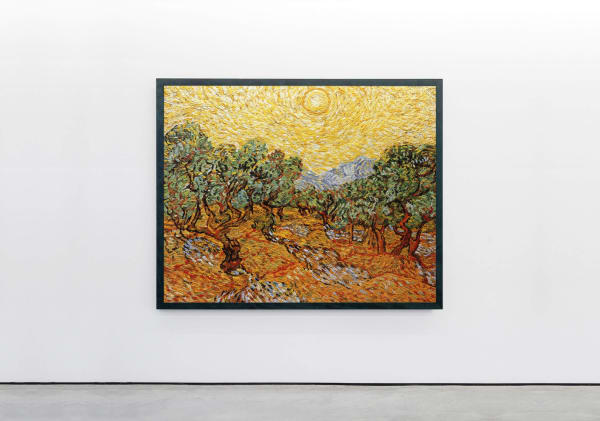-

Vik Muniz is known for his creative and referential works that challenge traditional art forms and question the nature of representation and perception. Artist's work often involves using everyday materials and objects, such as sugar, chocolate syrup, wire, and junk, to create large-scale portraits and scenes that comment on society, waste, and the environment.
"For me, the process of making art is as important as the final product. I want to explore the materials I use and discover new ways of creating."
– Vik Muniz
-
The 'Pictures of Garbage' series represents an appropriation of the renowned works by the old masters united by the common theme of ancient mythology. Through his works, Muniz challenges viewers to question their own assumptions about the value and beauty of objects, as well as their perception of reality.
Muniz is convinced that art should change the world for the better and should not be elitist at all. Through the implementation of unexpected techniques and thoughtful visual puns, his works capture the interest of any viewer, from connoisseurs of museum classics to a younger audience. The apparent ease of presentation of complex images turns his work into a kind of conduit to a new world of art and technology, linked to the achievements of early master artists and art history in general.
-
In 2010, he directed a documentary "Waste Land", which was nominated for an Oscar and won several prizes at the Toronto, Berlin and Sundance film festivals. It chronicles the largest landfill in the world, "Jardim Gramacho" on the outskirts of Rio de Janeiro. After auctioning off his series, "Pictures of Garbage", in the UK, Muniz donated the proceeds to the Garbage Pickers' Association of Jardim Gramacho, which marked the beginning of his extensive charitable work.
Throughout the film, Muniz works with the pickers to create a series of works using materials from the landfill, such as paper, plastic, and metal. The resulting large-scale photographs serve as a powerful commentary on the environmental impact of waste and the social injustice faced by waste pickers.
-
"My goal with Pictures of Garbage is to inspire people to think about the waste they generate and the impact it has on our world. I want to encourage people to be more mindful of their consumption habits and to make more sustainable choices.
– Vik Muniz
-
-
The film had a greater impact on the public, and as a result, by June 2012, the landfill was closed down. Some of the proceeds from the sales of the works were donated by Muniz to support the pickers who were out of work.
This project not only showcases the incredible artistic talent of Vik Muniz, but also highlights the importance of using art as a tool for social and environmental activism. Through his cooperation with the garbage pickers, Muniz raises awareness about the dignity and resilience of these marginalized individuals, as well as the pressing environmental issues that they confront on a daily basis.
-
 © Vik Muniz StudioThe works presented in this viewing room are united by a common theme of old mythology and are an appropriation of well-known works by old masters. The use of vintage, rusted, and broken pieces here only strengthens the connection between generations of artists, and the involvement of a large team of assistants in the project refers to large-scale projects of the Middle Ages, such as the creation of the Sistine Chapel mural.
© Vik Muniz StudioThe works presented in this viewing room are united by a common theme of old mythology and are an appropriation of well-known works by old masters. The use of vintage, rusted, and broken pieces here only strengthens the connection between generations of artists, and the involvement of a large team of assistants in the project refers to large-scale projects of the Middle Ages, such as the creation of the Sistine Chapel mural. -
-
In his painting Tiarini captures the essence of the myth of Vulcan, the Roman god, who in his forge, surrounded by other gods and servants, works to create arrows that Cupid uses to draw people into love.
The image of Cupid is an iconic symbol that continues to have an extensive influence on modern culture. It celebrates the idea that love can be both a blessing and a curse, and the profound impact it can have on a human life.
'Vulcan Forges Cupid's Arrows' by Alessandro Tiarini is featured in the Fondazione Pietro Manodori in Reggio Emilia, Italy.
-
-
-
-
The myth of the Cumaean Sibyl is one of the many stories included in the 'Metamorphoses' poem by Ovid. In the myth, Apollo fell in love with the beautiful Sibyl and offered to grant her a wish in exchange for her love. She took a handful of sand and asked to live for as many years as the grains of sand she held. That's how, remaining mortal, Sybil lived for over a thousand years.
-
-
-
-
-
'Hercules and Omphale' is a story from ancient Greek mythology that recounts about Hercules, the great demigod and the strongest man on earth, and Omphale, the queen of Lydia. According to the legend, Hercules had to complete a number of tasks, known as the "Twelve labors".
The story of Hercules and Omphale has been depicted in various works of art throughout the history, including paintings, sculptures, and ceramics, and remains one of the most popular themes in the classical art and culture.
'Hercules and Omphale' by François Lemoyne is a part of the collection of the Louvre Museum in Paris, France.
-
-
-
-
-
The Minotaur is a mythical creature from the Greek mythology, with the head of a bull and the body of a man. According to legend, Minotaur was imprisoned in a labyrinth built by the famous Daedalus on the orders of King Minos of Crete. The labyrinth was constructed so intricately that anyone entering it would never find their way out.
Legend says Minotaur fed on the sacrifices of Athenian men and women as tribute to Minos. Only the hero Theseus was determined to kill the monster and have tribute ended. He managed to find his way into the labyrinth, defeat the Minotaur, and escape with the help of the golden thread given to him by Ariadne.
The Minotaur remains an iconic image in art, literature, and folk culture with its powerful symbolism that fascinates the viewer.
'Minotaur' by George Frederic Watts is held in the Tate Britain in London, UK.
-
-
-
-
-
-
-
-
-
Atalanta was a human huntress whose name derives from the Greek 'atalantos' which means 'equal in weight.' She was celebrated for her beauty and her speed in running. Her father wanted her in marriage, but Atalanta agreed to marry only if the suitor could beat her at the footrace. The winner of this competition was promised the love, while the loser would have to face death.
Wishing to win the race, the young Hippomenes begged to the goddess Aphrodite for help, and she handed him three golden apples. The apples were so magnificent that every time Atalanta outran Hippomenes, he rolled an apple in front of her, and she couldn't resist stopping to pick it up. Thus Hippomenes won the race and married his beloved Atalanta.
'Atalanta and Hippomenes' by Guido Reni was painted between 1620 and 1625, and is currently in the collection in the Museo Nazionale di Capodimonte in Naples. This painting is a second version of the artist's earlier work on the same subject, which was completed between 1618 and 1619 and is now in the Museo del Prado.
-
-
-
-
-
'Atlas' by Barbieri depicts the story of the ancient Greek legend of Atlas, the Titan who was enforced by Zeus to hold the celestial spheres on his shoulders. The painting portrays Atlas as a powerful figure, holding the heavenly spheres with graceful ease.
The myth of Atlas has been a renown theme in the arts and literature throughout world history, and Guercino's painting shows the Titan and his fate as a symbol of endurance and strength.
'Atlas' by Giovanni Francesco Barbieri is a part of collection of Stefano Bardini Museum in Florence, Italy.
-
-
"I believe that everything we discard says something about us. Our waste reveals our consumption habits and our values."
– VIK MUNIZ
-
 Vik Muniz. 'Atlas', 2007 and 'Apollo and the Cumaean Sibyl', 2007 © Gary Tatintsian Gallery and the artist
Vik Muniz. 'Atlas', 2007 and 'Apollo and the Cumaean Sibyl', 2007 © Gary Tatintsian Gallery and the artist -
The works by Vik Muniz have been presented in collections of such museums as:
The Victoria and Albert Museum London, UK
Tate London, UK
The Museum of Modern Art (MoMA), New York, USA
The Guggenheim Museum, New York, USA
The Metropolitan Museum of Art, New York, USA
The Whitney Museum of American Art New York, USA
The Museum of Fine Arts Boston, USA
The Art Institute of Chicago, USA
The Menil Collection Museum, Houston, USA
The Museum of Contemporary Art in São Paulo, Brazil
The Museum of Modern Art, Rio de Janeiro, Brazil
The Museum of Contemporary Art of Rome (MACRO), Rome, Italy
The Irish Museum of Modern Art, Dublin, Ireland
The Joan Miró Foundation, Barcelona, Spain
The Tel Aviv Museum of Art, Tel Aviv, Israel
The Long Museum, Shanghai, China
The Museum of Contemporary Art, Tokyo, Japan
-
-
Find out more
-

Vik Muniz
-

Viewing Room | Vik Muniz. Olive Trees With Yellow Sky And Sun, After Van Gogh, 2007
22 February - 31 March 2024 -

Vik Muniz
2007 December 26, 2007192 pages 250 × 290 mm Weight: 1,2 kg Paperback ISBN: 978-5-9906881-8-6 -

Vik Muniz
Personal Exhibition 8 June - 10 October 2018 -

Vik Muniz. Russian Project
Personal Exhibition 1 November 2007 - 30 January 2008
-
-
-
Online Exhibitions
Viewing Room | ViK Muniz. Pictures Of Garbage
Past viewing_room






















































